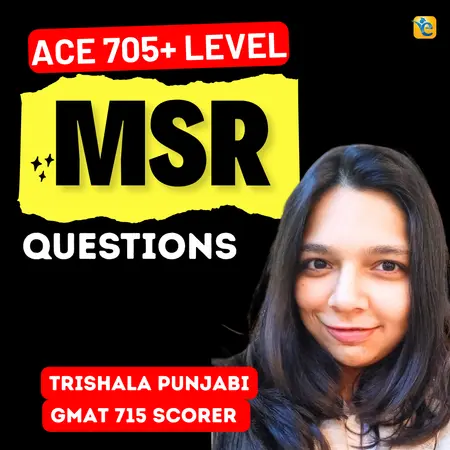Events & Promotions
|
|

GMAT Club Daily Prep
Thank you for using the timer - this advanced tool can estimate your performance and suggest more practice questions. We have subscribed you to Daily Prep Questions via email.
Customized
for You
Track
Your Progress
Practice
Pays
Not interested in getting valuable practice questions and articles delivered to your email? No problem, unsubscribe here.
- Nov 22
11:00 AM IST
-01:00 PM IST
Do RC/MSR passages scare you? e-GMAT is conducting a masterclass to help you learn – Learn effective reading strategies Tackle difficult RC & MSR with confidence Excel in timed test environment - Nov 23
11:00 AM IST
-01:00 PM IST
Attend this free GMAT Algebra Webinar and learn how to master the most challenging Inequalities and Absolute Value problems with ease. - Nov 25
10:00 AM EST
-11:00 AM EST
Prefer video-based learning? The Target Test Prep OnDemand course is a one-of-a-kind video masterclass featuring 400 hours of lecture-style teaching by Scott Woodbury-Stewart, founder of Target Test Prep and one of the most accomplished GMAT instructors.
C
Be sure to select an answer first to save it in the Error Log before revealing the correct answer (OA)!
Difficulty:
 95%
(hard)
95%
(hard)
Question Stats:
47% (02:20) correct 53%
(02:13)
wrong
53%
(02:13)
wrong  based on 1135
sessions
based on 1135
sessions
History
Date
Time
Result
Not Attempted Yet
Attachment:
Rhombus.gif [ 1.37 KiB | Viewed 89029 times ]
(1) The measure of angle BCD is 60 degrees.
(2) AE is parallel to BD
Kudos
Bookmarks
Quadrilateral ABCD is a rhombus and points C, D, and E are on the same line. Is quadrilateral ABDE a rhombus?
Rhombus is a quadrilateral with all four sides equal in length. A rhombus is actually just a special type of parallelogram (just like square or rectangle).
So ABCD is a rhombus means AB=BC=CD=AD.
ABDE to be a rhombus it must be true that AB=BD=DE=AE.
(1) The measure of angle BCD is 60 degrees --> diagonal BD equals to the sides of rhombus, so BD=AB. Know nothing about DE or/and AE. Not sufficient.
(2) AE is parallel to BD --> ABDE is a parallelogram (as AE||BD and BA||DE), hence opposite sides are equal: BD=AE and AB=DE. But we don't know whether all sides are equal (AB=BD=DE=AE). Not sufficient.
(1)+(2) From (1): BD=AB and from (2) BD=AE and AB=DE --> AB=BD=DE=AE --> ABDE is a rhombus. Sufficient.
Answer: C.
Attachments
untitled.JPG [ 3.95 KiB | Viewed 85249 times ]
Kudos
Bookmarks
'B' meets only one condition for a rhombus which is Parellelism. but it does not prove that all sides of ABDE are equal. Please see the attachment which suggests that 'B' only is not correct. We also need 'A' to prove all sides are equal. Hope it clarifies.
Attachments
![]() rhombus.doc [25 KiB]
rhombus.doc [25 KiB]
Downloaded 1606 times











